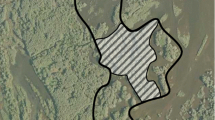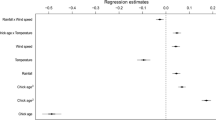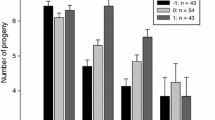Summary
Experimental enlargement of brood size in the glaucous-winged gull (Larus glaucescens) resulted in increased adult foraging time, decreased adult body weight at the end of the breeding season, and decreased over-winter adult survival. The decreased survival of breeding adults was associated with reduced body condition at the end of breeding (resulting from physiological costs of reproduction). Decreased survival was not due to an increased risk of injury or predation during the breeding season. Brood size did not directly affect the fecundity of surviving birds in the subsequent year. However, brood size may have an indirect effect on subsequent fecundity because the probability of mate loss increased among birds with large broods and the reproductive performance of birds with new mates was reduced. Based on estimates of life-time fitness calculated from fecundity and survivorship, birds with two- or three-chick broods (the normal brood size) have higher fitness than birds with one- or four-chick broods. However, the decreased fitness of birds with four-chick broods was slight, and probably not a sufficient explanation for the absence of natural four-chick broods in the glaucouswinged gull.
Similar content being viewed by others
References
Alerstam T, Högstedt G (1984) How important is clutch size dependent adult mortality? Oikos 43:253–254
Ankney CD, MacInnes DD (1978) Nutrient reserves and reproductive performance of female lesser snow geese. Auk 95:459–471
Askenmo C (1977) Effects of addition and removal of nestlings on nestling weight, nestling survival, and female weight loss in the pied flycatcher Ficedula hypoleuca (Pallas). Ornis Scand 8:1–8
Askenmo C (1979) Reproductive effort and return rate of male pied flycatchers. Am Nat 114:748–753
Bell G (1980) The costs of reproduction and their consequences. Am Nat 116:45–76
Calow P (1979) The cost of reproduction — a physiological approach. Biol Rev 54:23–40
Chabrzyk G, Coulson JC (1976) Survival and recruitment in the herring gull Larus argentatus. J Anim Ecol 45:187–203
Clutton-Brock TH, Guinness FE, Albon SD (1983) The costs of reproduction to red deer hinds. J Anim Ecol 52:367–383
Coulson JC, Wooller RD (1976) Differential survival rates among breeding kittiwake gulls Rissa tridactyla (L.). J Anim Ecol 45:205–213
Coulson JC, Monaghan P, Butterfield J, Duncan N, Thomas C, Shedden C (1983) Seasonal changes in the herring gull in Britain: weight, moult and mortality. Ardea 71:235–244
Dean JM (1981) The relationship between lifespan and reproduction in the grasshopper Melanoplus. Oikos 48:385–388
DeSteven D (1980) Clutch size, breeding success, and parental survival in the tree swallow (Iridoprocne bicolor). Evolution 34:278–291
Drent RH, Daan S (1980) The prudent parent: energetic adjustments in avian breeding. Ardea 68:225–252
Freed LA (1981) Loss of mass in breeding wrens: stress or adaptation? Ecology 62:1179–1186
Gillespie J (1977) Natural selection for variances in offspring number. Genetics 76:885–892
Goodman D (1974) Natural selection and a cost ceiling on reproductive effort. Am Nat 108:247–268
Harris MP (1964) Aspects of the breeding biology of the gulls Larus argentatus, L. fuscus and L. marinus. Ibis 106:432–456
Haukioja E, Hakala T (1979) On the relationship between avian clutch size and life span. Ornis Fennica 56:45–55
Hirshfield MF (1980) An experimental analysis of reproductive effort and cost in the Japanese medaka, Oryzias latipes. Ecology 67:282–292
Högstedt G (1981) Should there be a positive or negative correlation between survival of adults in a bird population and their clutch size? Am Nat 118:568–571
Hussell DJT (1972) Factors affecting clutch size in arctic passerines. Ecol Mon 42:317–364
Kleinbaum DG, Kupper LL (1978) Applied regression analysis and other multivariable methods. Duxbury Press, Mass
Law R (1979) The cost of reproduction in annual meadow grass. Am Nat 113:3–16
Norberg RA (1981) Temporary weight decrease in breeding birds may result in more fledged young. Am Nat 118:838–850
Nur N (1984) The consequences of brood size for breeding blue tits. I. Adult survival, weight change and the cost of reproduction. J Anim Ecol 53:479–496
Reid WV (1986) An inexpensive electronic balance and data recording system. J Field Ornithol 57:60–62
Reid WV (1987a) Life-history evolution in the glaucous-winged gull. Ph.D. dissertation U. Washington Seattle, p 207
Reid WV (1987b) Constraints on clutch size in the glaucous-winged gull. Studies in Avian Biology 10:8–25
Reznick D (1985) Cost of reproduction: an evaluation of the empirical evidence. Oikos 44:257–267
Ricklefs RE (1974) Energetics of reproduction in birds. In: Paynter RA Jr. (ed) Avian energetics, Publ Nuttall Ornithol Club No 15, pp 152–292
Ricklefs RE (1977) On the evolution of reproductive strategies in birds: reproductive effort. Am Nat 111:453–478
Ricklefs RE (1983) Comparative avian demography. Current Ornithology 1:1–32
Robinson SK (1986) Three-speed foraging during the breeding cycle of yellow-rumped caciques (Icterinae: Cacicus cela). Ecology 67:394–405
Røskaft E (1985) The effect of enlarged brood size on the future reproductive potential of the rook. J Anim Ecol 54:255–260
Shine R (1980) “Costs” of reproduction in reptiles. Oecologia (Berlin) 46:92–100
Stearns SC (1976) Life history tactics: a review of the ideas. Q Rev Biol 51:3–47
Stearns SC (1980) A new view of life-history evolution. Oikos 35:266–281
Tallamy DW, Denno RF (1982) Life history trade-offs in Gorgaphia solani (Hemiptera: Tingidae): the cost of reproduction. Ecology 63:616–620
Vermeer K (1963) The breeding ecology of the glaucous-winged gull (Larus glaucescens) on Mandarte Island, B.C. Occas Pap B C Prov Mus 13:1–104
Walsberg GE (1983) Avian ecological energetics. In: Farner DS, King JR, Parkes KC (eds) Avian Biology, Vol 7, Academic Press, New York, pp 161–219
Ward JG (1974) Reproductive success, food supply and the evolution of clutch size in the glaucous-winged gull. Ph. D. Thesis, University of British Columbia, Vancouver
Winfield IJ, Townsend CR (1983) The cost of copepod reproduction: increased susceptibility to fish predation. Oecologia (Berlin) 61:406–411
Author information
Authors and Affiliations
Rights and permissions
About this article
Cite this article
Reid, W.V. The cost of reproduction in the glaucous-winged gull. Oecologia 74, 458–467 (1987). https://doi.org/10.1007/BF00378945
Received:
Issue Date:
DOI: https://doi.org/10.1007/BF00378945




